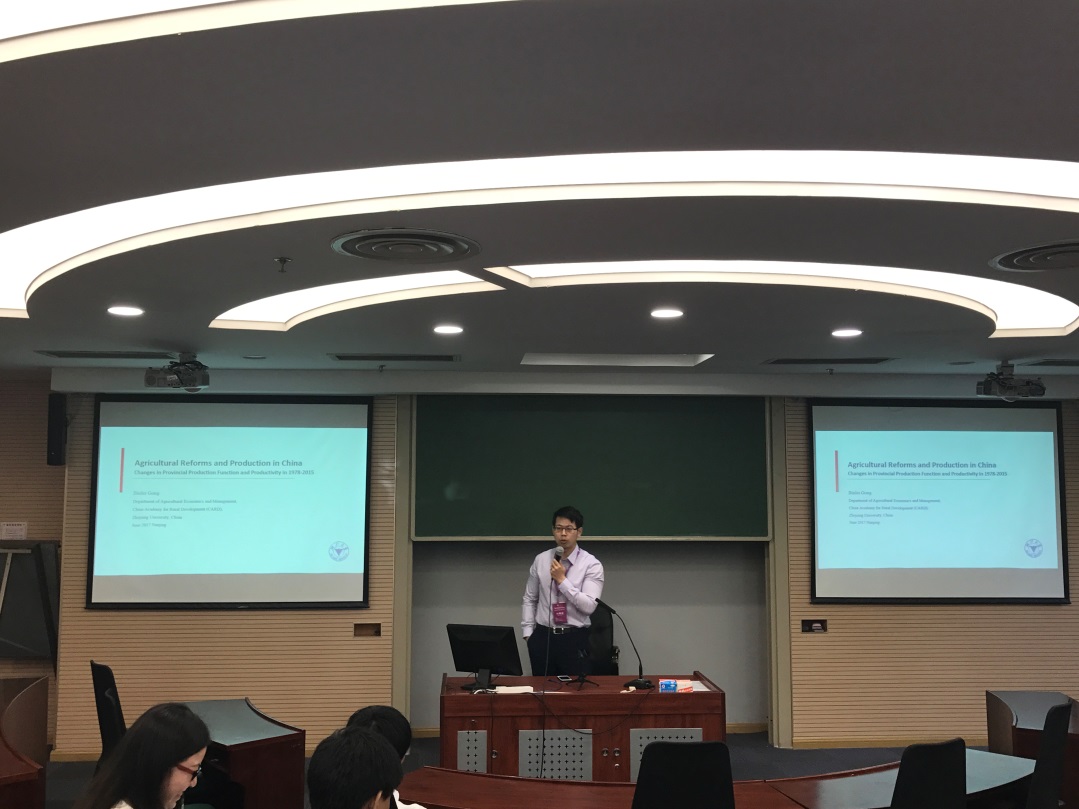农业经济与管理系百人计划学者、中国农村发展研究院龚斌磊研究员独著论文Agricultural Reforms and Production in China: Changes in Provincial Production Function and Productivity in 1978-2015(中国农业改革与生产:1978-2015年省际生产函数和生产率变化)被国际顶级学术期刊《发展经济学杂志》(Journal of Development Economics, JDE)录用。JDE是发展经济学最高期刊,属于SSCI经济类一区,浙大TOP期刊,上海财经常任轨目录一类期刊。本文梳理了改革开放后中国农村改革的进程并归纳为六个改革阶段,进而分析每个阶段农业生产函数和生产率的变化情况,是对农业农村改革四十年的回顾和展望。本文是以浙江大学为唯一署名单位被同级别经济学期刊录用的首篇论文,也是自1974年创刊以来第六位在JDE上独立发文的大陆学者(其余五位是林毅夫等来自北大、清华和人大的学者)。该论文是龚斌磊研究员本年度被录用的第四篇SSCI一区文章,在“2017 CES Annual Conference in China”(2017中国留美经济学会年会)上进行了宣讲,得到与会学者的广泛认可与好评。
中文摘要:
1978年起,一系列重大的、以市场为导向的农村改革重塑了中国农业结构,加速了农业增长。除了生产率,生产关系也随时间发生了重大变化。此外,由于农林牧渔的生产过程不同,农业内部结构(农林牧渔比例)的变动也导致农业总体生产函数的变化。与经典文献相比,本文利用变系数生产模型,允许投入弹性随时间和产业结构变动,从而更好的刻画了1978-2015年中国省际农业生产关系的变动情况。本文梳理了近四十年中国农村改革进程并归纳为六个改革阶段,进而分析每个阶段生产函数和生产率的变化情况。实证结果表明,改革开放以来,劳动力弹性降低,化肥和农机弹性提高,土地弹性呈现U型曲线,这体现了各投入要素重要性的变化趋势。此外,科技创新和投入要素在不同阶段交替引领农业产出的增长。在当前阶段,农业发展仍未完全摆脱粗放型的增长方式,这印证了中央政府提出技术创新和农业供给侧改革的必要性。
中文引言:
自1978年实施农业农村改革以来,中国农业出现了显著增长。与1949-1977年2.5%的增长率相比,1978-2015期间中国农业总产值(GVAO)的实际增长率为6.1%。在农业供给侧,一系列的市场化改革放松了管制,这不仅极大地提高了农业生产率,还重塑了农业生产过程和生产函数。
作为中国农业的四个部门,种植业、林业、畜牧业、渔业每一部门都有与自身生产特点相适应的生产方式。因此,总体农业生产函数取决于各省农业结构(农林牧渔比例)。中国的经济改革提升了人民的生活水平和食物消费水平,对动物蛋白需求的迅速增加提高了农业四部门中畜牧业和渔业的比例,这种需求侧的变化也在一定程度上改变了农业生产函数和生产关系。
综上,1978年开始实施的农业农村改革已经从需求和供给两侧改变了中国的农业生产。然而,农业改革也给中国农业问题的研究带来了两个难题。首要的问题是传统的固定生产函数假设无法准确识别农业改革前后投入产出关系的变化情况。为了解决这一问题,本文采用变系数生产函数,这种模型可以更好地控制和描绘农业演化过程中不断变化的投入产出关系,在研究中国农业历史变革中非常必要。
另一个难题是二十世纪九十年代以来关于中国农业生产率增长的争论。一些学者(Dekle and Vandenbroucke, 2010; Pratt et al., 2008; Wang et al., 2013)认为中国的农业生产增长率在九十年代后期达到顶峰然后逐渐回落;另一些学者(Chen et al., 2008; Chen, 2006a; Tong et al., 2009; Zhou and Zhang, 2013)指出九十年代后期中国已经出现农业生产增长率放缓的情况,随后又有所反弹。
本文通过两步法分析中国农业改革和发展进程。首先,本文利用变系数模型和随机前沿分析法,估计了省际农业生产函数和农业全要素生产率;其次,本文分析了中国农业改革六个时期投入弹性和生产率变化情况以及影响因素,进而评估不同农业政策对中国农业的影响。
本研究主要有三点理论贡献:第一,将半参数方法应用到中国农业部门,可以更好地刻画中国农业在改革背景下的变化情况;第二,本研究不仅评估了传统生产率分析中生产率的变化,还考虑了不同时期各省投入弹性的变化。第三,本文进一步将农业改革的六个时期与农业生产联系起来,并为学术界对中国农业生产率增长的争论提供了新的思路和启示。
实证结果表明:1)1978-2015年,农业生产函数随着时间和省份的变化趋势明显,从而反映出中国农业的变革和使用变系数模型的必要性;2)劳动力弹性呈下降趋势,肥料和机械弹性增加,而土地弹性随时间呈U型变化;3)中国农业生产率的增长有明显的周期性波动,科技创新和要素投入在不同改革阶段交替成为农业增长的源泉;4)在当前阶段,农业发展仍未完全摆脱粗放型的增长方式,这印证了中央政府提出技术创新和农业供给侧改革的必要性。
Abstract: A series of fundamental and market-oriented reforms since 1978 have dramatically reshaped China’s agricultural sector, which had been sluggish during the socialist period. Besides productivity growth and efficiency changes, the shape of the production function may also transform rapidly over time. Moreover, the four segments in agriculture (farming, forestry, animal husbandry, and fisheries) have different production processes and techniques, so the aggregated production function of agriculture may vary across provinces. Compared with existing studies, which usually assume a fixed production function, this paper allows a varying coefficient production function that can better capture the structure change in the six reform periods over the past four decades. The empirical results show that the labor elasticity is decreasing, the fertilizer and machinery elasticities are increasing, and the land elasticity has a U-shaped curve across time. Moreover, technology and inputs are leading the growth alternatively in different reform periods.
Introduction:
Remarkable agricultural growth has been witnessed in China due to the rural reforms implemented since 1978. The real growth rate in the Gross Value of Agricultural Output (GVAO) is 6.1% per year over the period of 1978-2015, compared with an average 2.5% increase in the socialist period (1949-1977). Several waves of institutional reforms and market deregulations in the supply side not only helped achieve tremendous improvement in productivity, but also overwhelmingly reshaped the agricultural process and production function of agriculture.
Farming, forestry, animal husbandry, and fisheries are the four segments in China’s agricultural sector, each with its own production process. Therefore, the aggregated production function of agriculture also depends on the share by segment in each province. Chinese economic reform has improved living standards and food consumption. The demand for animal protein has increased rapidly and therefore raised the ratio of animal husbandry and fisheries in the agricultural sector, which also altered the shape of the agricultural production function.
To summarize, the fundamental reforms that have been implemented since 1978 have reshaped agricultural production from both the demand side and the supply side. The first puzzle is that the traditional method with a fixed production function assumption fails to capture the changing input-output relation across time due to rural reforms in China. To solve this issue, this paper employs a varying production function to better control the impact of remarkable agricultural evolution, which is not only important, but also necessary.
Another puzzle is the debate about China’s agricultural productivity growth since the late 1990s. Some scholars (Dekle and Vandenbroucke, 2010; Pratt et al., 2008; Wang et al., 2013) assert that the productivity growth rate peaked in the late 1990s and then gradually lost its momentum. Other researchers (Chen et al., 2008; Chen, 2006a; Tong et al., 2009; Zhou and Zhang, 2013) point out that the significant slowdown had already happened in the late 1990s and subsequently rebounded.
This article analyzes China’s rural reforms and agricultural revolution using a two-step approach. In the spirit of the varying coefficient model and stochastic frontier analysis, this article first develops a semi-parametric approach to estimate the time- and province-variant production function, as well as total factor productivity (TFP). In the second step, we analyze the changes in input elasticities and productivity in six reform periods to determine the impacts of different rural policies on China’s agricultural sector.
This study makes three central contributions. Firstly, a semi-varying coefficient method is introduced to better capture the fundamental transition in China’s agricultural sector. Secondly, this study not only estimates the productivity and efficiency changes, as in classic productivity analysis, but also the changes in input elasticities across provinces and time. Thirdly, this article further links the six rural reforms in China with agricultural production and contributes to the debate about China’s agricultural productivity growth in the past 20 years.
The empirical results show that in 1978-2015: 1) the production function is indeed province- and time-variant, which reflects the fundamental transition of China’s agriculture; 2) the labor elasticity is decreasing, the fertilizer and machinery elasticities are increasing, and the land elasticity has a U-shaped curve across time; and 3) China’s agricultural productivity growth has obvious cyclical fluctuations and six cycles are witnessed. Moreover, the direction of changes in output and productivity has always been opposite in the past two decades, which indicates that technology and inputs are leading the growth alternatively in different reform periods. Finally, the input growth contributes more to the output in the current phase, which implies an extensive pattern of economic growth and that more technology innovation is needed to improve productivity.
Highlights:
model to varying input elasticity and productivity in China’s agricultural sector;
input elasticity and productivity changed drastically in the six reform periods;
there are obvious cyclical fluctuations in productivity growth;
technology and inputs lead agricultural growth alternatively across reform periods;
China is under an extensive pattern of growth and technology innovation is needed;



